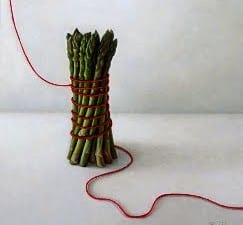A retrospective of the work of Walerian Borowczyk (1923-2006) is due to go on display at the ICA, London, this week. The Listening Eye highlights the artist’s extensive work in filmmaking, painting and sculpture. Primarily know from his erotic films such as Immoral Tales (1974) and The Beast (1975), Borowczyk also produced a number of animations, including Les Jeux des Anges (1964), Le Dictionnaire de Joachim (1965) and Le Théatre de Monsieur & Madame Kabal (1967). We speak to Associate Curator at the ICA, Juliette Desorgues, about what audiences can expect from the exhibition and their partnership with the BFI.
A: How would you define Walerian Borowczyk’s practice to someone who wasn’t familiar with him?
JD: Walerian Borowczyk’s art is incredibly varied. He covers everything from poster design, to hand-drawn and stop-motion animation, to erotic feature length films. Borowczyk embarked on a number of collaborations with key figures of the post war avant-garde, such as Bernard Parmegiani and Chris Marker, which in a sense is also reflected in the breadth of his work, from the more sombre quite surrealist animations such as Les Jeux des Anges to the more playful films Les Astronautes or Le Théatre de Monsieur & Madame Kabal.
A: What can audiences expect from the exhibition?
JD: The ICA show will feature some rarely seen archival material from his three defining early animations Les Jeux des Anges, Le Dictionnaire de Joachim and Le Théatre de Monsieur & Madame Kabal. Audiences will be able to view original artworks for the films as well as storyboards. All these pieces were assembled together on card by Borowczyk, which reveals his precise and meticulous way of working. In addition, the display will include some sound sculptures which Borowczyk created in the early 1970s. These were intended to be played and manipulated, and reveal his interest in the bringing together of different art forms and senses, imagery and sound.
A: The showcase coincides with a Walerian Borowczyk retrospective at the BFI, can you explain why you wanted to highlight his work in film too?
JD: Borowczyk is primarily a filmmaker, but whose approach to filmmaking was like that of a painter or a graphic designer. This is evident in his animation work and in a sense his feature films. The ICA will present two screenings of his shorts, which are mostly animation.
A: Can you identify any artists today who have been influenced by Borowczyk?
JD: Borowczyk’s work has been somewhat overlooked in recent decades, particularly in the UK. Many would have come across his art when it first came out in the 1960s and 1970s, at the time when artist or student-run cine-clubs were more common. Someone like Craigie Horsefield for instance, is a great admirer of his work, and you can to some extent see that in his photographs. Hopefully with this season and the launch of the DVD box-set which includes restored films, his output, in particular his animations, will be more accessible and inspire a younger generation of artists and filmmakers.
A: Why do you think now is a good time to reflect upon this important artist’s work?
Hopefully this season and display both at the ICA and the BFI will reignite a serious interest in Borowczyk’s practice, which is often remembered as pure base pornography (he directed one of the Emmanuelle films). His work, even his more erotic films, are far more sophisticated and artfully constructed than one might expect. I am sure his lesser known animation films, will be a true revelation to many. It is crucial his art is readdressed and the ICA feels like a natural home to showcase Borowczyk’s masterful talent.
Walerian Borowczyk: The Listening Eye, 20 May – 6 July, ICA, The Mall, London, SW1Y 5AH.
Cinema of Desire: The Films of Walerian Borowczyk, 20 May – 27 May, BFI Southbank, London.
Credits
1. Walerian Borowczyk, Renaissance, 1963 © Arrow films and Ligia Branice-Borowczyk.




